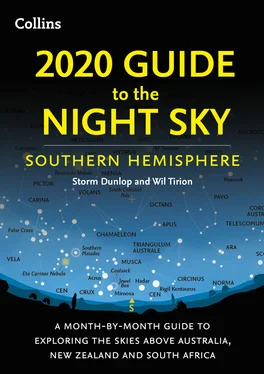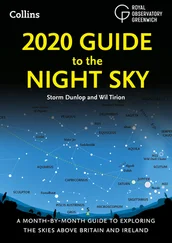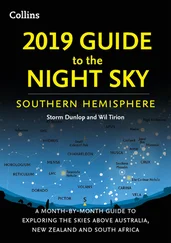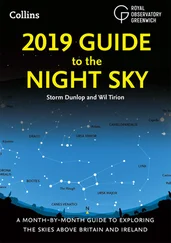Another factor that affects the visibility of objects is the amount of moonlight in the sky. At Full Moon, it may be very difficult to see some of the fainter stars and objects, and even when the Moon is at a smaller phase it may seriously interfere with visibility if it is near the stars or planets in which you are interested. A full lunar calendar is given for each month and may be used to see when nights are likely to be darkest and best for observation.
The celestial sphere
All the objects in the sky (including the Sun, Moon and stars) appear to lie at some indeterminate distance on a large sphere, centred on the Earth. This celestial spherehas various reference points and features that are related to those of the Earth. If the Earth’s rotational axis is extended, for example, it points to the North and South Celestial Poles, which are thus in line with the North and South Poles on Earth. Similarly, the celestial equatorlies in the same plane as the Earth’s equator, and divides the sky into northern and southern hemispheres. Because this Guide is written for use in the southern hemisphere, the area of the sky that it describes includes the whole of the southern celestial hemisphere and those portions of the northern that become visible at different times of the year. Stars in the far north, however, remain invisible throughout the year, and are not included.
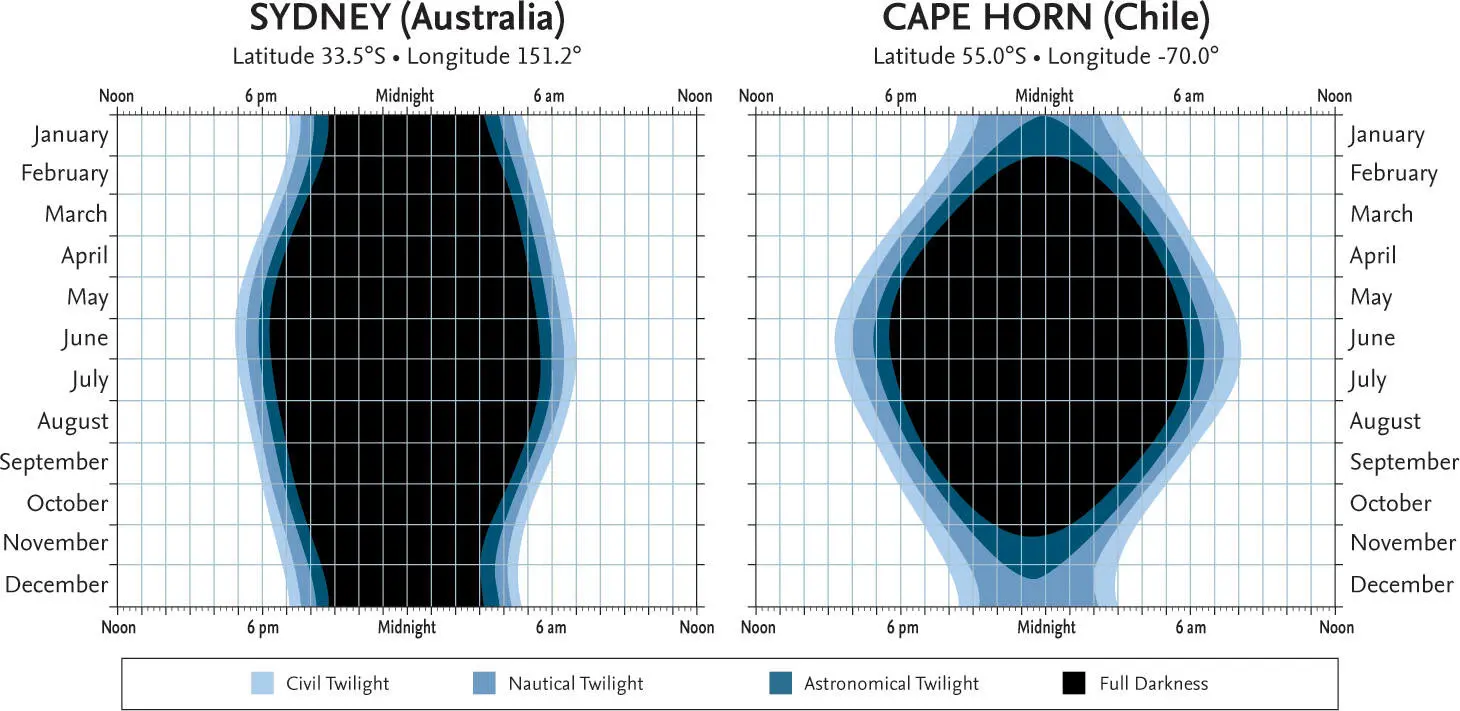
The duration of twilight throughout the year at Sydney and Cape Horn.
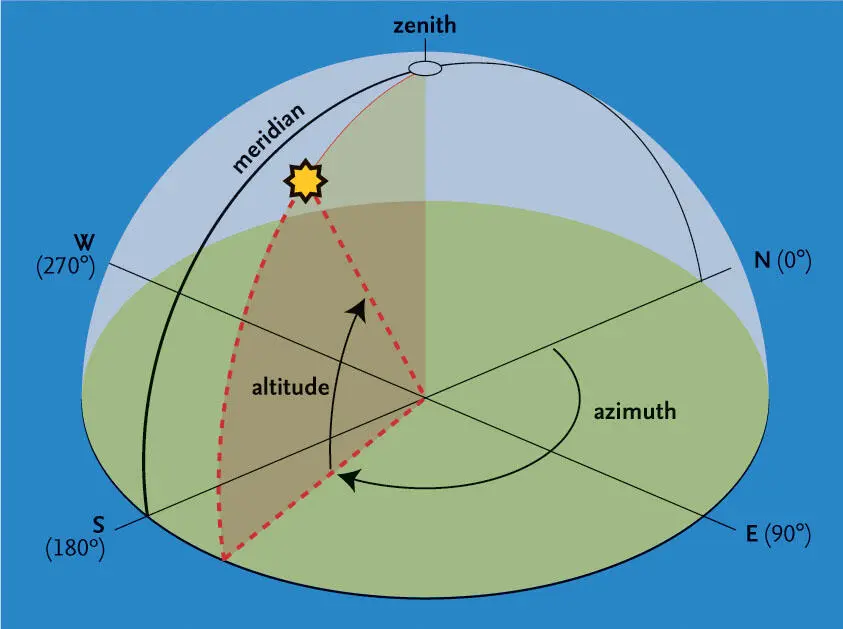
Measuring altitude and azimuth on the celestial sphere.
It is useful to know some of the special terms for various parts of the sky. As seen by an observer, half of the celestial sphere is invisible, below the horizon. The point directly overhead is known as the zenith, and the (invisible) one below one’s feet as the nadir. The line running from the north point on the horizon, up through the zenith and then down to the south point is the meridian. This is an important invisible line in the sky, because objects are highest in the sky, and thus easiest to see, when they cross the meridian. Objects are said to transit, when they cross this line in the sky.
In this book, reference is frequently made in the text and in the diagrams to the standard compass points around the horizon. The position of any object in the sky may be described by its altitude(measured in degrees above the horizon), and its azimuth(measured in degrees from north 0°, through east 90°, south 180° and west 270°). Experienced amateurs and professional astronomers also use another system of specifying locations on the celestial sphere, but that need not concern us here, where the simpler method will suffice.
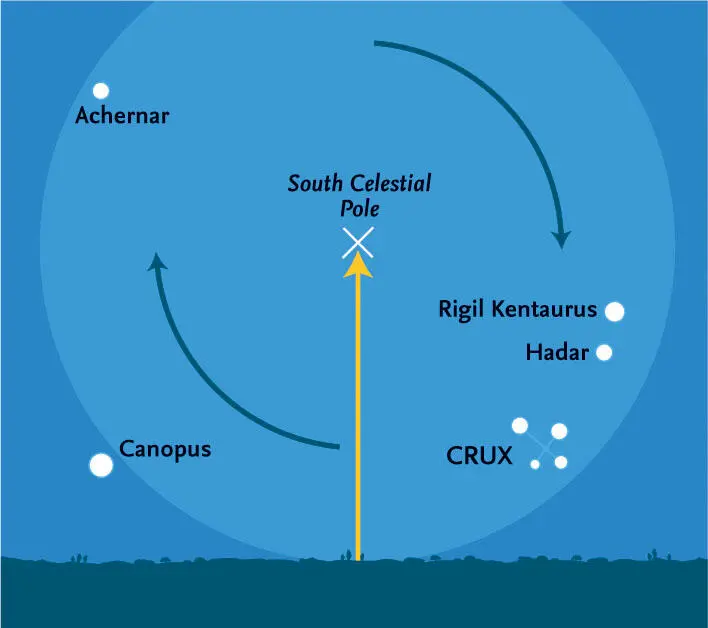
The altitude of the South Celestial Pole equals the observer’s latitude.
The celestial sphere appears to rotate about an invisible axis, running between the North and South Celestial Poles. The location (i.e., the altitude) of the Celestial Poles depends entirely on the observer’s position on Earth or, more specifically, their latitude. The charts in this book are produced for the latitude of 35°S, so the South Celestial Pole (SCP) is 35° above the southern horizon. The fact that the SCP is fixed relative to the horizon means that all the stars within 35° of the Pole are always above the horizon and may, therefore, always be seen at night, regardless of the time of year. The southern circumpolar region is an ideal place to begin learning the sky, and ways to identify the circumpolar stars and constellations will be described shortly.
The ecliptic and the zodiac
Another important line on the celestial sphere is the Sun’s apparent path against the background stars – in reality the result of the Earth’s orbit around the Sun. This is known as the ecliptic. The point where the Sun, apparently moving along the ecliptic, crosses the celestial equator from south to north is known as the (southern) autumn equinox, which occurs on March 20 or 21. At this time and at the (southern) spring equinox, on September 22 or 23, when the Sun crosses the celestial equator from north to south, day and night are almost exactly equal in length. (There is a slight difference, but that need not concern us here.) The March equinox is currently located in the constellation of Pisces, and is important in astronomy because it defines the zero point for a system of celestial coordinates, which is, however, not used in this Guide.

The Sun crossing the celestial equator at the September equinox (spring equinox in the southern hemisphere.).
The Moon and planets are to be found in a band of sky that extends 8° on either side of the ecliptic. This is because the orbits of the Moon and planets are inclined at various angles to the ecliptic (i.e., to the plane of the Earth’s orbit). This band of sky is known as the zodiacand, when originally devised, consisted of twelve constellations, all of which were considered to be exactly 30° wide. When the constellation boundaries were formally established by the International Astronomical Union in 1930, the exact extent of most constellations was altered and, nowadays, the ecliptic passes through thirteen constellations. Because of the boundary changes, the Moon and planets may actually pass through several other constellations that are adjacent to the original twelve.
The constellations
Since ancient times, the celestial sphere has been divided into various constellations, most dating back to antiquity and usually associated with certain myths or legendary people and animals. Nowadays, the boundaries of the constellations have been fixed by international agreement and their names (in Latin) are largely derived from Greek or Roman originals. Some of the names of the most prominent stars are of Greek or Roman origin, but many are derived from Arabic names. Many bright stars have no individual names and, for many years, stars were identified by terms such as ‘the star in Hercules’ right foot’. A more sensible scheme was introduced by the German astronomer Johannes Bayer in the early seventeenth century. Following his scheme – which is still used today – most of the brightest stars are identified by a Greek letter followed by the genitive form of the constellation’s Latin name. An example is the Pole Star, also known as Polaris and α Ursae Minoris (abbreviated α UMi). The Greek alphabet is shown here and a list of all the constellations that may be seen from latitude 35°S, together with abbreviations, their genitive forms and English names is here. Other naming schemes exist for fainter stars, but are not used in this book.
Asterisms
Apart from the constellations (88 of which cover the whole sky), certain groups of stars, which may form a part of a larger constellation or cross several constellations, are readily recognizable and have been given individual names. These groups are known as asterisms, and the most famous (and well known to northern observers) is the ‘Plough’, the common name for the seven brightest stars in the constellation of Ursa Major, the Great Bear. The names and details of some asterisms mentioned in this book are given in the list here.
Читать дальше
